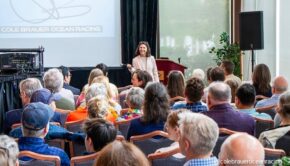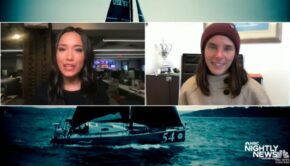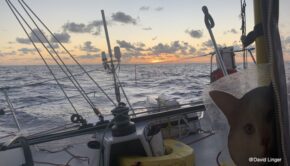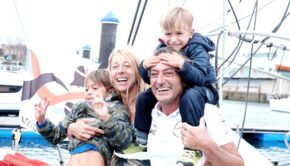Global Solo Challenge: We have a winner!
Published on February 24th, 2024
A Coruña, Spain (February 24, 2024) – Philippe Delamare (FRA) on his Actual 46 Mowgli today won the 2023-24 Global Solo Challenge, finishing with an elapsed time of 147d 1h 3m 37s. He had faced a serious storm to complete his circumnavigation, as two days prior got knocked down and broke his boom.
Cole Brauer (USA) is solidly in second position on her Class40 First Light and is expected to finish between the 6th and 8th of March but the exact date will become clearer once she clears the area of light winds of the Azores High. Her finish will make her the first American female to complete a solo, nonstop, circumnavigation by the three great capes.
Event organizer Marco Nannini provides the update:
Delamare’s arrival was triumphant, epic and emotional. Huge waves were smashing by the Tower of Hercules, the iconic outpost that marks the western end of the bay of A Coruña, the oldest lighthouse still in function, built nearly two millennia ago. Even driving a rigid work power boat we had to head out towards Philippe very slowly, and zig-zag to avoid breaking waves.
When we spotted a white sail behind the crests, it was initially difficult to keep visual contact; was it him? The sail kept approaching and disappearing behind walls of water, when we saw a first glimpse of Mowgli’s distinctive orange hull we all gasped: it was him!
He was sailing with just a partially furled headsail, two days before he had broken his boom and could not use the mainsail. The staysail halyard had ripped off the deck between Uruguay and Rio leaving him with a limited choice of sails.
The boat was rolling violently in the waves as Delamare followed the only safe approach to A Coruña in such weather conditions. There is a half mile gap between the coast and some rocky shallows to the north where waves were breaking heavily.
Mowgli kept going despite her numerous scars and all the signs of the hardship of the circumnavigation. A rescue boat of the Guardia Civil came out and seemed to be wanting to protect the boat and skipper on their last few miles.
They powered ahead and positioned themselves before the rocky shoals where Delamare had to gybe one last time to head south towards the finish line. When he did, the powerboat showed the way to the finish line between the breakwater and a lateral red buoy which also happens to be the safe channel to approach A Coruña in a storm.
As Mowgli crossed the finish line, the Guardia Civil started sounding their horn and Delamare raised his arms holding two red hand flares. We tried to keep the live streaming session going on Instagram and Facebook despite the waves and difficult conditions but thousands of people were connected from around the world to watch him fulfill a dream of a lifetime as well as take overall victory.
During the live broadcast, Brauer shared the live with her more than 400,000 followers and sent her congratulations. Congratulatory messages poured in from all over the world as well as from all the other competitors with internet access.
At the dock in Marina Coruña, a small group of family and friends who had braved the horrible weather were waiting for him to dock. The rain had stopped to let all witness the arrival, in between the morning and afternoon heavy downpours.
Delamare popped the cork of a local bottle of cava and dedicated most of the drink to Mowgli, generously pouring the sparkling wine on the deck and thanking her for the voyage, caressing the mast and letting her enjoy the bubbly and inebriating taste of success and victory.
He raised his trophy with that subtle smile that spoke a thousand words, probably aware that it would take quite some time for things to sink in, as five months at sea does not just come to a sudden end. Delamare then went to hug and meet all those who had waited, dreamed, and suffered with him throughout his circumnavigation.
Sailing legend Jean-Luc Van Den Heede paid a surprise visit and jokingly said it was strange for him to be the one welcoming Delamare after a circumnavigation as he has so many times been on the other side.
Van Den Heede wanted to enter the event on the boat he had completed his first circumnavigation on, taking second place in the 1986 BOC Challenge on Let’s Go. He would have liked to close the circle of his stellar career as navigator by sailing his last circumnavigation on the boat that had first taken him around the world.
Unfortunately, some technical details which would have required work and resources made him resist. There was some friendly banter as Delamare said it would have made winning a lot harder, if not impossible, had the record holding French veteran had made it to the start.
More and more details came to light as the tired but relaxed winner told of his adventure. He shared with us that he had very nearly stopped in Hobart. He spent a week where many things went wrong in quick succession and he felt overwhelmed, unsure if he wanted to take on the long Pacific crossing with mounting technical problems.
When he reached Cape Leeuwin, after a relatively issue-free navigation to that point, he had problems starting his engine. He used to run it every five days for 45 minutes to ensure all was in order but around the time he was celebrating his second cape, the starter circuit had seemed to have suffered damage, and despite many attempts, he could not manage to get the engine running.
He tried to bridge the positive and negative by the starter motor using a big screw driver as big sparks flying everywhere. He tried so many times that he eventually caused a temporary blackout to the instruments with the autopilot tripping off and leaving him with the boat rounding into the wind. He eventually had to accept he could not address the issue and did not try further.
Soon after, his primary autopilot ram broke, and while he had a spare and installed it, this left him with no backup just as he was about to leave the Indian Ocean for the Pacific. Then he broke both his lazy jacks and the sea state was making it very hard to solve the issue with a climb up the mast out of the question. In another accident, one of the deck rests of his spinnaker pole was ripped out, leaving him dealing with a leak from the deck.
The quick succession of issues was not over yet, as Mowgli hit some floating object which tore off one of the supports of his hydro generator. Delamare had to take parts from his spare unit to make a repair. All this was adding to his concerns, the thought of going further with only one fully functional hydogenerator made him apprehensive, especially as he could not count on the engine to recharge batteries.
A total blackout in the Pacific would have left him with the Hydrovane as a backup. Perhaps, having decided to install a mechanical windvane was one of those elements that finally tipped the scale in favor of the decision to continue.
All these challenges at once were a real test of his resolve. One of his knees, which had been bothering him, became severely inflamed, causing him to feel unwell. The news that Dafydd had stopped in Hobart was a real blow to his morale and he had to dig really deep.
When he realized that the aluminum profile of his genoa furler had become disconnected at the top, he felt it was the last straw and that’s when he was coming to terms with the need to stop in Hobart.
He was still several days away from Tasmania and finally the quick succession of problems seemed to have come to an end.
As he kept sailing, he realized he could keep 2-3 turns on his genoa and keep use of the partially furled sail, he put a stopper knot on the furling line so that the sail could never completely unfurl. His knee started to get better. If his hydrogenerator broke again, he thought perhaps he could find a way to generate electricity by rigging the leg some other way from the stern.
As for the autopilot ram, he became convinced that the unit had some issue from the start as it sometimes made a grinding noise he could never quite understand. He forced himself to believe the backup ram would work just fine. Time helped him process each issue and figure out possible solutions. He managed to push along the front of the mast a makeshift lazy jack and his thoughts started to shift his focus from a possible stop in Hobart to one in Ushuaia.
When he passed Cape Horn, the boat had done well without further problems and his knee had healed, although now a lumbago forced him to walk on all fours on deck. He felt, however, confident enough the boat could sail on and in his blog he joked about his less than elegant movement on the boat.
Once he reached the latitude of Uruguay, he managed to restart his engine, perhaps also aided by higher temperatures and a lesser peak current needed to get it going.
As he proceeded on his long climb north, whilst beating upwind between Uruguay and Rio, his staysail furler attachment ripped off the deck. He had to deal with a delicate situation with the sail flogging in the air as he tried to wrestle it down and a sizeable section of the deck damaged. From that point on, he could only use his furled genoa instead, making it more difficult to sail close to the wind in stronger winds.
The navigation through the trades and north, however, was uneventfully pleasant and it was only at the time he reached the Azores that it became clear that he would face a serious storm on his approach to the finish line.
I asked him why he took the risk, and he said he has a philosophy on the matter. If it’s impossible to proceed he will indeed back off, but if looking at the scenario he hesitates, he feels that tells him it’s still feasible and he should fight his hesitation and go for it. “I don’t like the thought of coming to the realization I have lost needless time or worse, I would hate to lose miles and time just to have an issue anyway.”
When he approached Cape Horn, he could have certainly slowed just enough to pass behind the storm that was blowing by the cape. However, he felt it was not bad enough to justify slowing down, not so much for the immediate loss of miles by the cape, but because he would have also lost the weather train north after his rounding.
In fact, by pressing on at Cape Horn, he also found very strong favorable winds till the Falklands. “It was not a matter of losing hours, it would have cost me several days,” he explained.
The same can be said for his final storm by the Iberian Peninsula. “It was not a simple situation, there was nowhere to go other than effectively staying near the Azores. It was not just one but a series of storms on the way. I was hesitant, so therefore I knew I could do it.”
His approach to the Galician Coast was no joke, and two days before finally crossing the finish line, the sea state had already built to over seven meters. At one point, the boat rolled and wiped into the wind. Delamare was below and hesitated a few precious moments before coming on deck.
The mainsail sheet came off the self-tailer and the boom was pushed forward by the wind as the boat came upright and went into an involuntary gybe, the boom flew across from one side to the other and smashed against the rigging breaking in two. “It certainly could have gone a lot worse, and I am aware I took some risks, but it was in line with what I felt I wanted to do and I am happy to have continued.
“Had I decided to avoid the storm, I think I could have not reached A Coruña before Wednesday (Feb. 28) as there was another storm right behind, I would have lost at least 3-4 days and perhaps encountered other difficulties anyways as the area affected by the storms was so vast that being at sea wouldn’t have been all that easy.”
Finally, I asked him about his boat and how he felt about the choice and if he’d make the same choice again. “When I decided to enter the Global Solo Challenge, I was thinking of getting a Finot Conq design, and as I saw the ‘Challenge’ as a race I wanted a racing boat.
“Initially I was looking for a Pogo 40S, just like that of Francois Gouin. I then learnt more about the boat and about Class40 racing. I realized that perhaps at my age and with my racing experience, I could not push a racing boat to its rating. A racing boat requires a lot of work and a lot of effort to be sailed near its potential.
“I wanted to enjoy my voyage and not live day after day on the limit having to constantly push the boat hard, it is a different way of sailing, and I concluded I didn’t have the desire nor, perhaps, the skill. I therefore decided to look for a boat that would be reliable, solid and that I, personally, could push close to 100% to its potential at all times.
“I looked at many many boats until the opportunity to buy Mowgli came up, an Actual 46. She is a traditional boat designed in the late 80s and of a size that gave me comfort. Also, I thought I knew how to sail a boat of this kind and get the most out of it.
“I bought Mowgli effectively as a project boat and I spent 10 months working every day on her for a total and complete refit, including new mast, sails, electronics. The boat was certainly well prepared. I had in fact chosen an affordable boat so that I had enough budget to prepare her well.
For example, I had two completely independent autopilots with independent wiring and sensors, professionally installed, which was not cheap for sure, but I did not want to have a more expensive boat and less budget to prepare it with the care and systems redundancy I wanted.”
Talking to Delamare is fascinating and gives an insight into his philosophy, about sailing and other things, that make him the unique and extraordinary individual that he is, who committed to his project and stayed true to it from start to finish, achieving his personal dream as well as an extraordinary human and sporting performance.
There is so much more that we could say and we will follow up with more stories. For now, congratulations to the immense Philippe Delamare.
Race details – Entry list – Start times – Tracking
Attrition List:
DNS: Peter Bourke – Class40, Imagine
DNS: Ivan Dimov – Endur37, Blue Ibis
DNS: Curt Morlock – IMOCA, 6 Lazy K
DNS: Volkan Kaan Yemlihaoğlu – Open 70, Black Betty
RTD: Juan Merediz – Class40, Sorolla
RTD: Dafydd Hughes – S&S 34, Bendigedig
RTD: Ari Känsäkoski – Class40, ZEROchallenge
RTD: Ronnie Simpson – Open 50, Shipyard Brewing
RTD: Édouard De Keyser – Solaire 34, SolarWind
RTD: Pavlin Nadvorni – Farr 45, Espresso Martini
RTD: William MacBrien – Class40, Phoenix
RTD: Kevin Le Poidevin – Open 40, Roaring Forty
The inaugural Global Solo Challenge 2023-24 seeks to be a budget-friendly solo, non-stop race around the world. Using a pursuit format for the 2023-24 race, 20 entrants from 34 to 70 feet have start times between August 26 to January 6 from A Coruña, Spain, with the first boat to return deemed the winner.
Source: GSC









 We’ll keep your information safe.
We’ll keep your information safe.